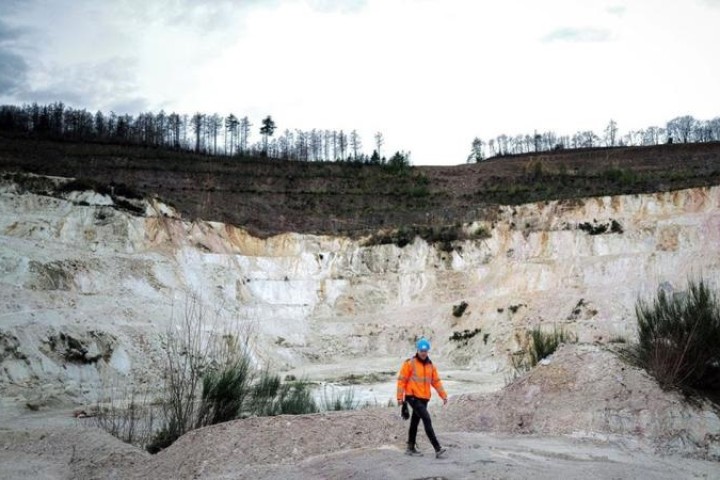Lithium in France: Future Opportunities and Challenges

Lithium, known as the white gold of the 21st century, the use of this metal in the medical field and in batteries has become very important and highly valued. The Japanese company Sony was responsible for marking a turning point in the use of lithium in batteries, being the first to launch the first rechargeable lithium-ion battery on the market.
The applications are numerous so its use is currently widespread, for example, in our cell phones and computers, even in the area of medicine but the great use that has been given is in electric vehicles, which are becoming increasingly important in this world affected by climate change and environmental crisis.
According to a report published in 2021 in Nature, the lithium-ion battery market will grow from $30 billion in 2017 to $100 billion in 2025. But what and how exactly is lithium.

PHOTO BY CÉDRIC GERBEHAYE, NATIONAL GEOGRAPHIC IMAGE COLLECTION
Lithium is a soft, silvery metal, the third lightest element in the universe, along with hydrogen and helium among the first elements when the planet was formed. It was discovered in 1817 in a fragment of volcanic rock. Its name comes from the Greek “lithos” meaning “stone”.
It is classified as an alkali metal, if combined with water it forms alkalis or chemicals that stabilize acidic solutions. With a small atomic weight and radius, lithium is heat resistant with high melting and boiling points, making it capable of harboring large amounts of energy.
In which region of France is it available?
In the Alsace region (geothermal lithium) and some areas of the Auvergne-Rhône-Alpes region this metal has been found available.
Allier is a French department located in the Auvergne-Rhône-Alpes region, after months of study and several drillings, interest was shown in a mine located in the subsoil of a kaolin quarry located in Beauvoir, in the center of the country, this site hosts since 1850 a quarry where 30,000 tons of kaolin are produced per year.
The “Emili” project, proposed by the company Imerys, aims to help Europe get rid of its dependence on lithium from China by becoming the only company that will be able to sell electric vehicle batteries to the European Union.
Alessandro Dazza, CEO of Imerys, also declared that the exploitation of this deposit “will help Europe to decarbonize” and, in the face of probable environmentalist criticism, Imerys indicated that the mine would adopt an international standard that seeks to reduce toxic emissions and minimize water consumption.
There are initiatives to explore lithium in other regions of the country, as demand for this mineral is increasing due to its use in batteries for electric vehicles and energy storage.
Below is an image showing the presence of lithium-bearing minerals and deposits with high potential.

What would be the risks and opportunities for French people?
One of the risks for the French population is dealing with the effects or consequences of the lithium extraction process as it generates toxic emissions, groundwater contamination and high water consumption. In terms of emissions, it is estimated that about eight kg of CO2 will be generated per ton of lithium, which is significantly less compared to the 16 to 20 kg emitted in Australia and China, emitting less pollution to the environment.
Harnessing lithium can help France remain competitive in the global economy, especially in the automotive and battery sector.
But finally, the opportunities generated include thousands of jobs and the improvement of the electric vehicle market by using lithium themselves and not buying it from countries such as China, whose dependence is what the European Union is trying to reduce.
France24 states that, in the long term, the company promises 1,000 direct and indirect jobs in the Auvergne-Rhône-Alpes region, at two sites: the subway extraction mine containing the lithium, between 75 and 350 meters deep; and a mineral purification and lithium hydroxide processing plant, less than 100 kilometers from the mine.
Lithium batteries are now essential to facilitate the energy transition. As we move away from the use of fossil fuels towards renewable energy sources, applications of this mineral help to reduce CO2 emissions that generate the greenhouse effect. However, the mining required to obtain this raw material has several adverse effects, both on the natural environment and on the social sphere, risks that require the adoption of solutions that prevent the environmental and social consequences for the French people.
How can we reduce CO2 emissions through the use of lithium?
This metal is becoming key and is emerging as an option for several countries in the face of the climate crisis and thus abandoning fossil fuels.
For example, electric vehicles such as Tesla that use lithium batteries offer the advantage of storing renewable energy such as solar and wind power. Linda Gaines, a transportation systems analyst at Argonne National Laboratory in the United States, says that “the big push to use lithium-ion batteries is for electric vehicles that will reduce dependence on fossil fuels.”
Lithium-ion batteries facilitate renewable energies and produce less carbon emissions in the face of the large emissions generated by the transportation sector annually.
French Environment Minister Barbara Pompili, in an interview with Les Echos, made it clear that, “France needs long-term contracts for imports, but also to get our own lithium at home. If we want to be a society that emits less greenhouse gases, we must face the consequences, we need materials such as lithium”.
Although lithium offers many benefits and is a different solution against climate change, there are also drawbacks, especially with its extraction process, which is why dependence on lithium must be increasingly sustainable, moving towards a circular economy that prioritizes recycling and reuse.
The European Union has set a target of recycling 70% of lithium by 2030. Companies in Germany, Belgium and the United States are developing technologies to recycle mainly small batteries, such as cell phone batteries, with a capacity to reuse up to 70% of the materials and recycle between 7,000 and 10,000 tons annually.

